7 /10 1 Votes
7/10 IMDb Magazine Afternoon Final episode date 21 December 2008 Network AT-X | 6.9/10 MyAnimeList Genre Chanbara, Supernatural First episode date 13 July 2008 Number of episodes 13 | |||||||||||||||||||||||||||||||||
Characters Kagehisa Anotsu, Makie Otono-Tachibana, Hyakurin Cast Tomokazu Seki, Daisuke Namikawa, Rina Satō, Mamiko Noto, Kazuya Nakai Similar Infinite Ryvius, Burst Angel, Devil Hunter Yohko, Argento Soma, Basilisk | ||||||||||||||||||||||||||||||||||
Blade of the immortal trailer
Blade of the Immortal (Japanese: 無限の住人, Hepburn: Mugen no Jūnin, lit. "The Inhabitant of Infinity") is a Japanese manga series by Hiroaki Samura. The series is set in Japan during the mid-Tokugawa Shogunate period and follows the cursed samurai Manji, who has to kill 1000 evil men in order to regain his mortality. The manga was originally published in Afternoon from June 25, 1993, to December 25, 2012. A 2008 anime adaption was produced Bee Train and Production I.G. Also in 2008, the novel Blade of the Immortal: Legend of the Sword Demon was released in Japan by Kodansha, and two years later in the United States by Dark Horse Comics. A live action film adaptation of the same name is scheduled for release in 2017.
Contents
- Blade of the immortal trailer
- Plot
- Story arcs
- The world of Blade of the Immortal
- Manga
- Anime adaptation
- Film
- Editing in the English language adaptation
- Reception
- References

Plot

Blade of the Immortal follows the deeds of Manji, a skilled samurai who has a decisive advantage: no wound can kill him, except for a rare poison. In the past, his criminal actions led to the death of 100 other samurai (including his sister's husband). He becomes immortal at the hand of an 800-year-old nun named Yaobikuni, and is compelled by the death of his sister to accept the quest that will end his agelessness. He has vowed to make amends by killing 1000 evil men, and until he does Manji will be kept alive by "sacred bloodworms" (血仙蟲, kessen-chū), remarkable creatures that allow him to survive nearly any injury and reattach severed limbs even after hours of separation. They work by sacrificing themselves to seal the wound - they're worms that were bred to be as close in their chemical and physical make-up to humans as you can get without being human. They cannot handle regrowth on a large scale, but, for example, can reattach a severed limb or seal a hole in the brain.
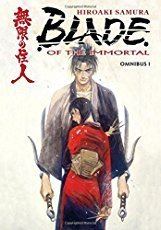
Manji crosses paths with a young girl named Asano Rin and promises to help her avenge her parents, who were killed by a cadre of master swordsmen led by Anotsu Kagehisa. Anotsu killed Rin's father and his entire dōjō, making them a family of outcasts. Anotsu's quest is to gather other outcasts and form an extremely powerful new dojo, the Ittō-ryū (a school teaching any technique that wins, no matter how exotic or underhanded), and has started taking over and destroying other dojos.
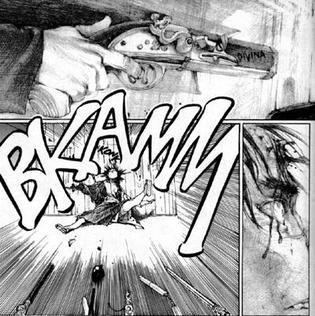
In addition, another group calling itself the Mugai-ryū has emerged, in opposition to the Ittō-ryū. Its true leadership and motives are initially a mystery, but its methods (any tactics that leads to victory) resemble those of the Ittō-ryū. They try to enlist Manji's help as they seem to want the same thing. Eventually Manji joins but quickly pulls out after he finds out a member, Shira, is way too sadistic for his tastes. After a while Manji finally discovers that the Mugai-ryū work for the government. They are all death row inmates who are allowed to live only if they serve the shogunate. While Manji and Shira quickly grow to hate each other, after Shira runs off, Manji remains on friendly terms with the other members of the group.
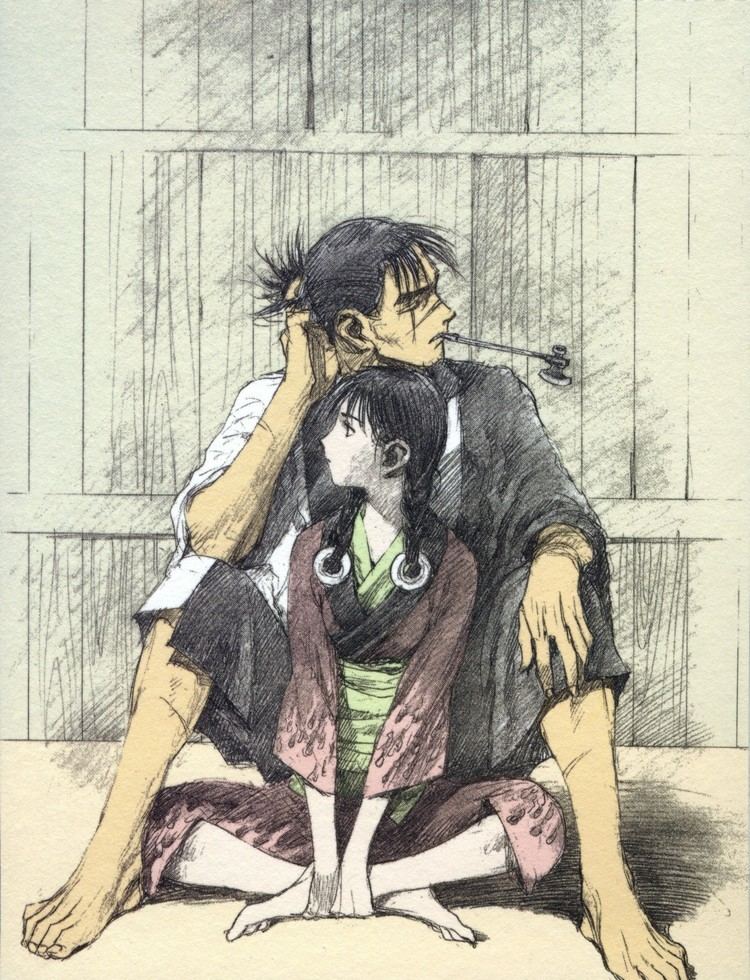
In a broader context, the series covers the effects of death and the consequences of not being able to die, as well as the meanings behind living. Most of the principal characters have some sort of purpose which they inexplicably discover through the events that transpire.
Story arcs
Blade of the Immortal is divided into four story arcs:
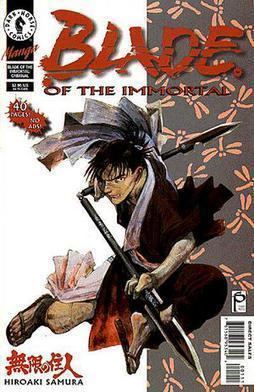
- Introduction (序章, Joshō): Antelude to Act 20
- In the first story arc, the reader is introduced to the main characters, plot, central conflict and overall theme of the series ("documenting the human struggle"). The plot is superficially simple: Manji and Rin wander around Edo, occasionally meeting members of Ittō-ryū on their quest to find Anotsu. However, the bulk of Samura's philosophical ruminations can be found in this introductory story arc, from obsession, duty, the burden of time and revenge / redemption. Part of Samura's appeal is in not painting his "villains" with black-and-white strokes; even the supposed antagonist Anotsu, who espouses an "end justifies the means" philosophy, elicits sympathy from the reader via his ultimate goal - in that, fighting the widespread corruption of his era and therein fashioning a stronger Japanese society.
- Kaga Arc (加賀編, Kaga Hen): Acts 21 to 79
- The second story arc introduces the Mugai-ryū, a mysterious sword school intent on hunting down Anotsu Kagehisa. After killing several minor members of Ittō-ryū, Mugai-ryū enlists Manji and Rin to help them track down the elusive Anotsu. Manji and Rin eventually get separated, as Rin decides it would be better for her to hunt Anotsu alone; Manji attempts to track her across province borders and ends up in a vicious fight with three Ittō-ryū members. The story then follows the separate characters as they pursue their various goals: Anotsu to unify his sword school with the remote Shingyoto-ryū in Kaga; Rin on her quest to locate Anotsu; Manji's recovery from his wounds and his search for Rin; Magatsu's hunt for the murderous Shira. The evolution of Samura's style can be seen particularly in this story arc: gone are the elaborate "death murals" and the stronger focus on inking denotes a preference for 'hard' technique in contrast to 'soft' depiction (very little penciling). The first truly despicable villain is also introduced in this story arc, the sadistic mercenary Shira who delights in blood and torture.
- Elucidation of Immortality Arc (不死力解明編, Fushiryoku Kaimei Hen): Acts 80 to 134
- The third story arc begins with a few apparently random fights that, in consequence, lead Manji to join up with the shogunate in fighting Ittō-ryū. However, the government has a more devious plot, and imprisons Manji for issue after issue of experimentation, hoping to reproduce the effects of the kessen-chu.
- Final Chapter (最終章, Saishū Shō): Act 135 to Final Act
- The fourth and final story arc concluded in the Japanese run of the manga in December 2012.
The world of Blade of the Immortal
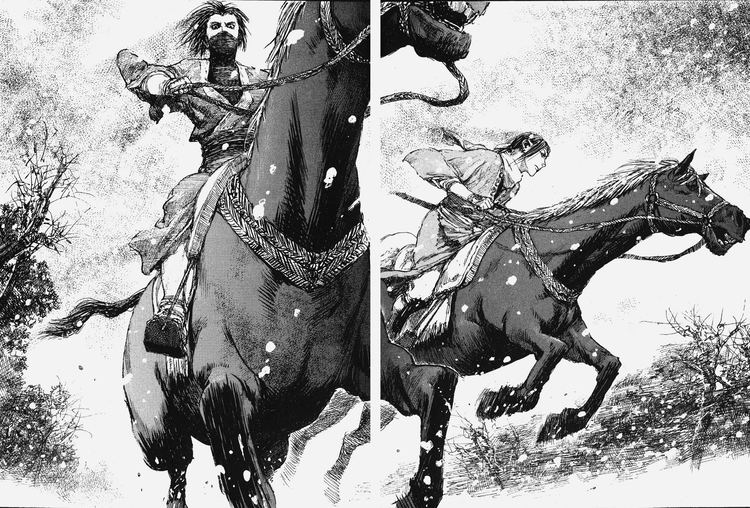
A bloodworm (kessen-chu) is an unexplained little worm-like creature, which lives in the bloodstream and tissue in a symbiotic way. It heals all wounds acquired by its host, replacing the missing tissue and organs with their own bodies as well as reattaching limbs. Many of the "scars" on Manji's body are actually worm flesh, holding Manji together like living sutures. However, it is noted that the bloodworms can only heal wounds acquired during infestation and not ones that were acquired prior (such as Manji's eye). They also do nothing to prevent pain. The only way to kill a bearer of the bloodworms is to use a bloodworm poison, although it has been implied that cutting off their head may suffice if it is not reattached quickly. During his battle with Makie, Manji said the only way to stop him would be to cut off his head. But whether this would kill him or just leave him unable to function is debatable, because in his battle with Eiku Shizuma, Manji cuts off his head after poisoning him with his own sword, and he does not die until after the kessen-satsu (blood worm killer) takes effect. Further adding to the debate were statements in Wizard magazine that Manji could survive a severed head, but it would take at least a year for the blood-worms to regenerate that much tissue. While not yet covered in the English version of Blade of the Immortal, another immortal is partially beheaded (to the point where only a flap of skin is keeping its head attached) only for the wound to heal within a few seconds. This essentially confirms that Manji's regenerative abilities would allow him to survive a beheading. The time in which it takes for regeneration varies: Manji can reattach a limb within seconds and can partially recover from a bullet or stab wound to the brain. However the wounds to his head did have a negative effect (incapable of moving his lower body or weaker vision). Apparently, the kessen-chu give immortality to its host and everlasting youth (the host retaining the age they had at the time they were fed the kessen-chu). It is unknown how to infect a person with the kessen-chu, but Shizuma indicates it takes a lot more than blood to blood contact with someone who's infected. In later chapters the question how to transfer them becomes a major part of the story.
The weapons found in Blade of the Immortal are largely fictional, most created by Samura, who confesses he has no idea what some of them are supposed to do. Usually, major characters have unique and specialized weapons - hidden crossbows, throwing knives, poisoned blades, and even weapons meant to inflict maximum pain. Manji himself carries a number of blades - Sukehiro Amatsubaki ("Rain Camellia"), Kotengu ("Little Devil"), Okorobi ("Man Toppler"), Merabi ("Lady Gadfly"), Karasu ("The Crow"), Shidō ("The Four Paths"), Imo-no-Kami Tatsumasa ("Sister Defender Tatsumasa"), a spear-like weapon called Aun, and an unnamed hooked weapon. Some of Samura's other creations include Giichi's thresher-like throwing blade, known as Kanetsura's Mito-no-Kami ("Guardian of the Three Paths"), which he uses to sever the heads of his enemies, and Anotsu's large Kabutsuchi battle-axe, which was based on an example from Nepal.
Manga
The original Japanese manga has been collected into 30 volumes (tankōbon) by Kōdansha's Afternoon KC division. The English version of the manga is published by Dark Horse Comics. On October 11, 2007, Dark Horse dropped the monthly issues. The following issues were released through trade paperback volumes.
Anime adaptation
On 23 March 2008, it was announced that an animated television series adaptation of the manga would be directed by Kōichi Mashimo and produced by Bee Train in summer 2008. The first episode premiered on July 14, 2008 on AT-X channel. The opening theme is "Akai Usagi" (赤いウサギ, lit. "red rabbit") by Makura no Sōshi, and the closing theme is "Wants" by GRAPEVINE. American company Media Blasters has acquired the license to the series and released it in September.
Film
The manga will be adapted into a live action film. It will be directed by Takashi Miike, with the screenplay by Tetsuya Oishi, and starring Takuya Kimura as Manji. It is scheduled for release in 2017.
Editing in the English language adaptation
To preserve the integrity of his art, Samura requested that the publisher of the licensed English translation, Dark Horse Comics, not "flip" the manga (that is, reverse the pages as if in a mirror). At the time the English translation began its publication in individual monthly issues (1996), flipping was an almost universal practice for translated manga. Instead, Blade of the Immortal was modified for Western readers by the unusual method of cutting up the panels and rearranging them on the page in order to have the action flow from left to right.
Although American industry practice has now largely changed over to publishing translated manga in its original right-to-left orientation, Blade of the Immortal has retained the labor-intensive cut-and-paste method. The publisher cautions that rearranging the panels is not foolproof, and can lead to continuity errors; this usually occurs when the flow of text bubbles is dependent upon character placement within panels. In such cases, individual panels or entire pages may be flipped, and occasionally the artwork is modified accordingly; for instance, a retouch artist may draw a scar over Manji's left eye to disguise a flipped panel, though this is not always the case. Sound effects within the panel may also be retouched out and re-lettered in English, or removed completely. Japanese sound effects that are an integral part of the artwork are usually left as is. Additionally, text bubbles or panel borders may be redrawn, and script pacing may be subtly altered in order to preserve suspense or the placement of text bubbles.
In the monthly Dark Horse serialization, colored versions of title pages from the corresponding manga chapter are often featured as cover art, though in some cases a different piece of artwork, such as a tankōbon cover, may be used, usually in cases where the original title page depicts graphic subject matter. The original Japanese tankōbon, which are not subtitled, also collect more chapters than the English volumes published by Dark Horse; as such, they are considerably longer and do not directly correspond to the English numbering scheme. The original tankōbon also contain different cover and interior art, and may contain additional special features, such as character biographies.
Another reason for not "flipping" in the English version is Manji's clothing, which features a manji symbol, is that if the pages were "flipped" it would resemble the Nazi swastika instead of the Japanese character Manji. (Some publishers issued an explanation of this in several issues, particularly in Norway.) Manji is Japanese for "the character for eternality" 萬字, and represents Dharma, universal harmony, and the balance of opposites.
Reception
The series won an Excellence Prize at the 1997 Japan Media Arts Festival and the Will Eisner Comic Industry Award in 2000 for Best U.S. Edition of Foreign Material. In the QuickAndSimple listing of the top 10 anime, Blade of the Immortal secured 10th place.
